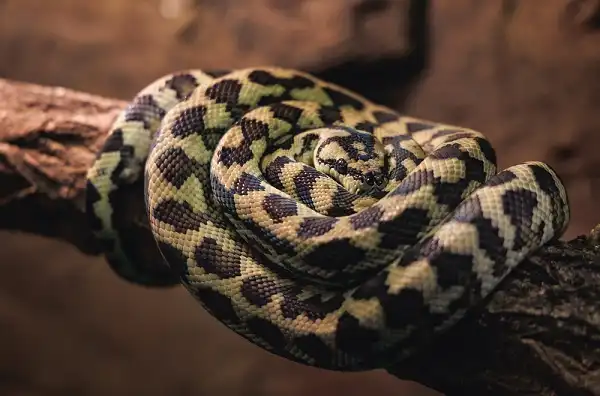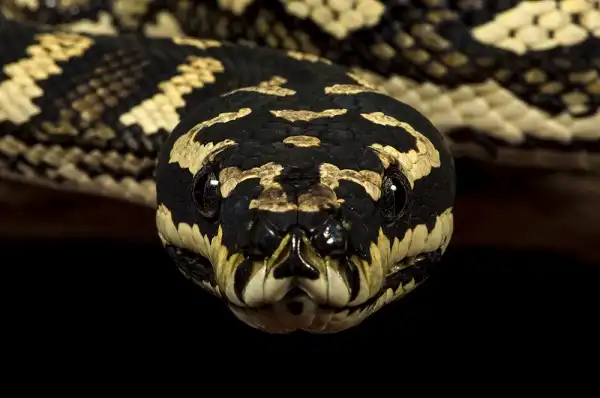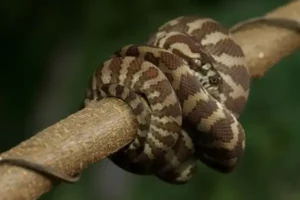If you’re an avid pet owner, then you may have heard of the Carpet Python – a large species of snake native to Australia, Indonesia, and Papua New Guinea. Boasting beautifully patterned scales that come in all sorts of colors and sizes, the carpet python is sure to draw attention from anyone who sees it! With their ability to adapt to different climates and habitats as well as ideal habits for living within humans’ homes, these reptiles make wonderful companions for reptile lovers alike. In this blog post, we explore why carpet pythons are so great and some tips on caring for these unique pets. Enjoy!

Carpet Python Description
Carpet Pythons are a large species of snake that are native to Indonesia, Australia, and Papua New Guinea. They get their name from the distinctive patterns on their scales, which come in a variety of sizes and colors. Carpet Pythons typically have small heads, thick bodies, and long tails. The overall color varies from pale yellow to rich browns, often with black-tipped scales along their backs. Common patterning includes diamonds, stripes, spots, or a combination of all three. Carpet Pythons make great pets if cared for properly since they are relatively docile animals that don’t require much space or attention. Due to their impressive size and fascinating patterns, Carpet Pythons have become increasingly popular amongst reptile owners over the last few decades. If you’re considering getting one of these beautiful creatures as a pet it’s important to do your research beforehand as there are some specific needs that must be met in order to keep them healthy and happy.
Carpet Python Habitat
Carpet Pythons are naturally found in Australia, Indonesia, and Papua New Guinea. They prefer warm climates and tropical jungles as their natural habitat, but can also adjust to living indoors with the proper lighting and humidity levels. Since they are native to these areas, they require temperatures between 77 and 86 degrees Fahrenheit during the day, with nighttime temperatures dropping to 68-77 degrees Fahrenheit. Providing a large enclosure with plenty of hides, and branches for climbing and basking surfaces, will give your pet enough space to explore as well as provide them comfort. To replicate their natural environment, it is important to provide full spectrum UVB lighting for 12-14 hours a day in order to produce beneficial amounts of Vitamin D3. This helps carpet pythons digest food properly since it regulates calcium metabolism. It is also important that owners maintain proper humidity levels of 50-60% within the enclosure through regular misting or other methods like foggers/humidifiers so that your pet can shed their skin properly.
Carpet Python Diet
Carpet Pythons are not picky eaters and will generally eat anything they can overpower. They feed primarily on small mammals, such as mice, rats, and birds, but can also be fed a variety of other animals including lizards, amphibians, and other reptiles. However, these should only be used as a supplement to their regular diet due to the small size of prey that carpet pythons typically hunt. When feeding your pet in captivity it is highly recommended to purchase pre-killed rodents or chicks that are sold in pet stores or online. It is also important that owners provide their carpet python with a balanced diet by providing them with different sizes of prey items along with an appropriate amount of calcium and vitamin supplements. Prey items should be defrosted before being offered to your pet and must always be slightly larger than the widest part of their body so that they can swallow it safely. For younger snakes, it’s best practice to feed them every 5-7 days while adults should be fed every 10-14 days.

Carpet Python Size
Carpet Pythons are a large species of snake, typically growing between 3 and 6 feet in length. However, some varieties may grow up to 12 feet in length! They have small heads, thick bodies, and long tails. The overall color of these snakes varies from pale yellow to rich brown, often with black-tipped scales along their backs. Depending on the variety, they may have unique patterning such as diamonds, stripes, spots, or a combination of all three.
Carpet Python Lifespan
Carpet Pythons can live for up to 20 years when properly cared for and given the right environment and nutrition. Depending on the individual, some may live even longer, with records of 25-30 years in captivity. In the wild, however, their lifespan is typically much shorter due to factors like predation and exposure to disease. In order to ensure a long, healthy life for your pet Carpet Python, it is important to provide them with an appropriate habitat that mimics their natural environment as closely as possible. By following these steps along with regular vet visits and veterinary checkups, you will be able to ensure that your Carpet Python has the best chance at living a long life.
Carpet Python Behavior
Carpet Pythons have a semi-arboreal lifestyle, which means they spend some time in trees or on branches. They are mainly active during the night but may be seen during the day if there is enough warmth and light provided. This snake species has a calm temperament and is rather docile, making them a popular choice as a pet. In the wild, Carpet Pythons are solitary creatures that prefer to be left alone. Captive-bred specimens may become more accustomed to being handled and may even curl up around their owner’s arm in a sign of trust. However, it is important to handle your pet properly by supporting its entire body at all times and never grabbing it from above or below the neck area. As with any other reptile species, Carpet Pythons can become stressed very easily so it is important to provide them with a comfortable environment that mimics their natural habitat as closely as possible. Finally, it is important to remember that Carpet Pythons are naturally curious animals who may attempt to investigate unfamiliar objects or items within their enclosure as well as any changes in their environment.

Carpet Python Speed
Carpet Pythons are relatively slow-moving snakes, but they have the ability to accelerate quickly if needed. Their speed is determined by their environment and can vary depending on the surface they are moving across or the obstacles they encounter. In the wild, they can move at speeds of up to 1.5 mph (2.4 km/h). In captivity, Carpet Pythons may not be able to attain this kind of speed due to limited space in their enclosure. Even if it does have ample room, an individual’s age and size can also affect its speed as younger and smaller specimens may be slower than larger individuals that are more accustomed to moving quickly when hunting prey.
Carpet Python Hunting
Carpet Pythons are ambush predators, meaning they typically wait in one spot and strike when their prey gets close enough. They are experts at camouflage and will use their patterned scales to blend into their environment. In addition to using their coloration for concealment, they will also flatten out their bodies in order to appear thinner and more inconspicuous. This combination of tactics allows them to remain undetected as they wait for the perfect moment to strike. When hunting, Carpet Pythons typically move slowly but can accelerate quickly if needed.
They rely heavily on their sense of smell and vision to locate their prey, often isolating it from a distance before moving in for the kill. Once close enough, they will bite down on the victim with their sharp teeth and constrict around it until it has succumbed to death by suffocation or cardiac arrest. Once captured, Carpet Pythons will swallow their prey whole; however, in some cases, they may take longer than usual due to large prey items being difficult to consume. This is why it is important to provide appropriate-sized food items when feeding your pet snake as larger prey can increase the risk of regurgitation or even death if not properly digested.
Carpet Python Reproduction and Breeding Behavior
Carpet Pythons are oviparous, meaning they reproduce by laying eggs. Females will typically lay 3-12 eggs in a clutch and the incubation period is usually between 55-75 days, depending on the temperature. In order to successfully breed Carpet Pythons, it is important to provide them with a cool-down period before the breeding season begins. This involves keeping their temperatures lower than usual (around 75°F) for 4-6 weeks in order to trigger mating behavior. Once the female has laid her eggs, it is important to remove them from the enclosure and place them into an incubator at a temperature of 84-86°F with a humidity level of around 60%. The eggs should hatch within 55-75 days, depending on the temperature and humidity of the environment they are kept in. Overall, breeding Carpet Pythons requires patience and careful attention in order for successful reproduction and the hatching of healthy offspring.

Carpet Python Common Health Issues
Carpet Pythons are generally quite hardy animals, but they can become susceptible to health issues if their environment is not properly maintained. Common health problems that may arise in Carpet Pythons include respiratory infections, mites, parasites, and mouth rot. Mites are another common health issue with Carpet Pythons and can be caused by unclean cages or contact with other animals that carry mites. These pests feed on your pet’s skin cells and scales which can cause irritation, redness, and itching. In order to get rid of them, it is important to regularly clean your snake’s enclosure as well as its substrate and furnishings.
If necessary, you can also use mite treatments which will kill off any existing infestations quickly and safely. Parasites such as tapeworms or roundworms may also pose a potential threat to your pet’s health if left untreated. Symptoms such as vomiting, loss of appetite, lethargy, weight loss, or diarrhea should be noted immediately so that prompt action can be taken in order to eliminate any parasites that may have been present within the snake’s system.
Conclusion
Carpet Pythons are a species of snakes that originate from Australia and they possess an impressive hunting technique that involves them using their sense of smell and vision to locate prey. They rely heavily on their environment for survival so it is important to provide them with the correct humidity and temperature levels in order for them to stay healthy. Breeding these reptiles requires patience and dedication as well as careful monitoring in order for successful reproduction to occur.
Frequently Asked Question


